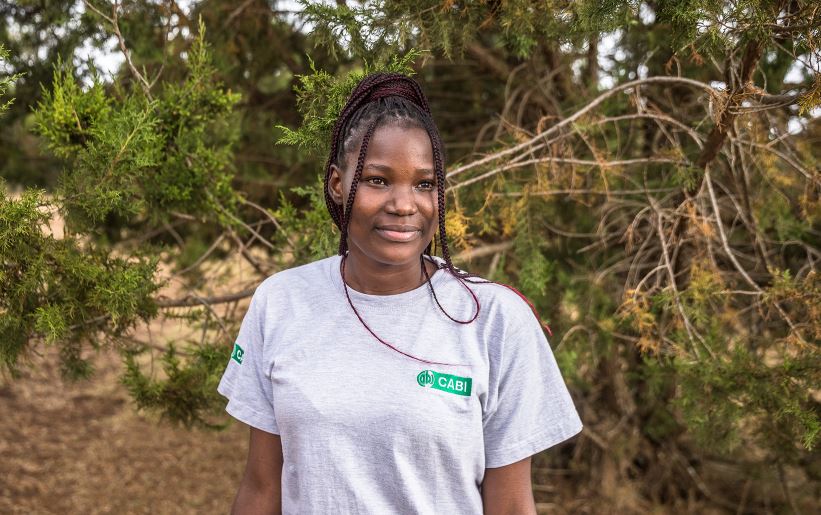
CABI has shared its expertise in drone management of insect pests at the Entomology 2023 conference which was hosted by the Entomological Society of America (ESA).
The conference, which took place in person at the Gaylord National Resort & Convention Centre in National Harbor, Maryland, USA, and online, was held under the theme ‘Insects and influence: Advancing entomology’s impact on people and policy.’
Violet Ochieng’, Research Officer-Drone Technology is CABI’s very own certified drone pilot and gave an online presentation of her research at a symposium, held during the conference, hosted by the International Association of Black Entomologists (IABE).
Certified drone pilot
Violet, who is based at CABI’s regional centre for Africa in Nairobi, Kenya, gave a presentation entitled ‘Exploring drone technology in insect pests management: A case study of desert locusts.’
Her talk highlighted her research, published in the journal Drones in April this year, which determined the optimum height for a drone to fly and target desert locusts with biopesticides for it be most effective to fight the devastating crop pest.
Violet, the first winner of the Carol Ellison Science Award – which is awarded to a student doing her/his research with CABI – with the objective of enriching their research experience with the organisation, conducted her study with funding from the award.

The desert locust is one of the most destructive migratory pests in the world. In 2019-2020, according to the Food and Agriculture Organization (FAO), around 20 million people in Ethiopia, Kenya, Somalia, South Sudan, Tanzania, and Uganda faced acute food insecurity due to swarms of desert locust.
In Kenya, the outbreak represented the worst locust crisis in 70 years; by its peak, the country was tackling over 500 swarms in 28 of Kenya’s 47 counties.
Need to introduce new technologies
Violet highlighted how existing ways of managing desert locusts presented some challenges and that there was a need to introduce new technologies to complement traditional methods.
“Drones are very targeted and can treat infestations that might otherwise be difficult to reach with vehicle-mounted or hand spraying methods,” she said.
In her study, which was also conducted in partnership with fellow scientists from the University of Nairobi, CABI and Astral Aerial Solutions, Violet found that a height of 10 metres is best for the drone to spray biopesticide on the desert locust below.
Violet added, “To test the optimum height for spraying Metarhizium acridum on the locusts, the drone was flown at five different heights: 2.5 metres, 5 metres, 7.5 metres, 10 metres, and 12.5 metres.

“At each height, the drone sprayed the ink mixture on spray cards pinned to the ground to approximate the droplet density and compare it to the standard droplet density recommended for desert locust control.”
To assess the efficacy of M. acridum and the effectiveness of drones in its application, 50 grams of spores were mixed in 1 litre of diesel and sprayed on caged live locusts of different stages (3rd and 4th instars, as well as the adults); they were monitored for twenty-one days in a controlled room, and their mortality was determined.
“Variation in droplet density between the tested heights was significant. A height of 10 metres agrees with the recommended standard droplet density within the 45 droplets/cm2 range,” she said.
Mortality varied
The scientists found that mortality varied among the locusts’ developmental stages within and between heights. Survival probability varied between heights for 3rd instar, 4th instar, and adults. All the developmental stages of the desert locust were susceptible to Novacrid, and the recommended target stage is the 3rd instar.
Dr Ivan Rwomushana, a co-author on the paper and CABI’s Senior Scientist, Invasive Species Management, said the study demonstrated that spraying desert locusts using a drone at any height below 10 metres may lead to over-deposition of the biopesticide. But heights above 10 metres may lead to under-application, which may limit exposure of the locusts to Metarhizium spores or pesticide molecules.

In her presentation, Violet outlined a range of recommendations. She said higher flights of between 90-110 metres should be selected for extensive surveillance to identify green vegetation that shows the likelihood of locusts being present.
On the other hand, low altitudes 30-50 metres above the ground are recommended for intensive surveillance to get detailed information such as the size of area infested and the stage of the locust.
Violet ended by stating that CABI is now further exploring the potential application of drones in precision agriculture that may include the temporal pattern/distribution of crop pests.
Main photo: Violet Ochieng’ (right) shared CABI’s expertise on the use of drone technology to tackle crop pests including the desert locust (Credit: Ivan Rwomushana/CABI).
Other relevant stories and blogs
‘Transforming agriculture with drones: empowering youths for a sustainable future.’
‘Study determines optimum height for drones to fly and target desert locusts with biopesticide.’
‘Exhibition of the DroneSight for Desert Locusts Management during Nairobi Innovation Week at the University of Nairobi.’
Related News & Blogs
ADB Story highlights fight against desert locusts
The Asian Development Bank (ADB) has published a story on its website which highlights the fight against desert locusts in Pakistan. Entitled ‘Pest-Proof, Climate-Ready, Resilient Agriculture: Pakistan,’ the story is concerned with the ‘Strengthening F…
26 October 2022




